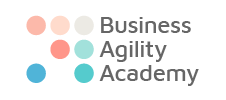Learning Objectives
Introduction
The goal of this set of learning objectives is to provide an introduction to the topic of business agility. It will cover the imperative for business agility, as well as the drivers necessary to achieve it. Topics covered will be from a leadership perspective and, as such, will not cover the mechanics of agile development. It is agnostic and, thus, is not specific to any particular framework or approach. Instead, it aims to be principles-based and, therefore, applicable to multiple organizational contexts.
Course Format
The course can be taught in multiple formats, and we encourage educators to create an offering that is most suited to their client’s needs. It can be a live instructor-led class, self-paced online, or hybrid. It is up to educators to ensure that the learning objectives are met by every student. In order to maintain quality, we will gather feedback from every student. Suggested learning time, 16 hours.
Course Delivery
This class may be designed and delivered by any approved educator holding the E-BAC credential.
Course Prerequisites
None.
Licensing Information
These learning objectives were created by Karim Harbott and Sohrab Salimi for the Business Agility Association. This work is licensed under the Creative Commons Attribution-NonCommercial-NoDerivatives 4.0 International License. To view a copy of this license, visit http://creativecommons.org/licenses/by-nc-nd/4.0/.
Learning Objectives
1 – The Why & What of Business Agility
The intent of this learning objective is to create a sense of urgency for and a shared understanding of what Business Agility is.
- Compare and contrast the main characteristics of plannable, predictable work, and unpredictable, creative work.
- Explain the term VUCA and its consequences on the nature of the work undertaken by organizations.
- List at least three key drivers of the dramatic increase of VUCA in the late 20th and early 21st centuries.
- Describe how business agility can provide a competitive advantage in a high VUCA environment.
- Outline at least five key organizational impediments to greater business agility.
- Describe at least two real-world case studies of business agility.
2 – Organizational Culture
The intent of this learning objective is to enable participants to connect to what organizational culture is so that they can talk about and ultimately change it.
- Explain the importance of organizational culture and its impact on the effectiveness of organizations.
- Outline at least one framework for assessing and shifting organizational culture.
- Assess the compatibility of various culture types with business agility.
- List at least three factors, which can be directly controlled, and which can influence the culture of an organization.
3 – Agile Leadership
The intent of this learning objective is to create a shared understanding of what Agile Leadership can look like and provide concrete examples and next steps for participants.
- Describe the circumstances in which management emerged, and list some early management pioneers.
- List at least three reasons that traditional management becomes less effective in high-VUCA environments.
- Define agile leadership and outline how the mindset of agile leaders differs from that of more traditional leaders.
- Explain the benefits of decentralizing decision-making and the necessary conditions for doing so.
- Outline at least one established leadership approach which is highly compatible with agile leadership.
4 – People & Engagement
The intent of this learning objective is to demonstrate what up-to-date HR practices can look like and how they are connected to Business Agility.
- Explain the significance of employee engagement on organizational performance.
- List at least five factors that impact employee engagement.
- Outline the negative impact of some key traditional HR practices on creative knowledge workers.
- Describe at least three progressive HR practices which are well aligned with business agility.
5 – Organizational Structure
The intent of this learning objective is to outline the shifts needed in organizational structures and how leaders can directly impact organizational culture through structures.
- Explain how structural decisions can have a direct impact on the performance of teams, and that different structures will optimize for different traits.
- Compare and contrast the key traits of activity-focused teams and outcome-focused teams, and when each may be appropriate.
- List at least five attributes of high-performing teams, and how leaders can help to put those things in place.
- Outline at least one established team development approach.
- Explain at least three patterns for multiple teams to collaborate towards a common goal, and how leaders can facilitate these.
6 – Governance & Funding
The intent of this learning objective is to connect how governance and funding can impede or support Business Agility.
- Explain the pros and cons of projects vs products as a vehicle for funding work.
- Outline some key challenges of funding decisions based on business cases and a fixed scope.
- List at least three governance policies which are aligned with creative, innovative work with high uncertainty, and explain why they are effective.
7 – Leading the Change
The intent of this learning objective is to provide participants with a clear understanding of how to approach change within their organizations.
- List at least three reasons why organizational change often fails.
- Outline at least one established change management approach which could be used to move towards greater business agility.
- Describe at least two real-world case studies of successful business agility transformations and outline the high-level approach they took.
- Explain at least three principles which underpin successful business agility transformations.

